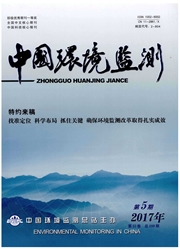

 中文摘要:
中文摘要:
对2013—2016年基于国家环境空气质量监测站以及省建大气多参数站所获取的南京市O3、NO2、CO、VOCs、PANs观测结果进行综合评价,结果表明:2016年南京市O3第90百分位日最大8 h平均质量浓度比2013年上升33.3%,超标天数中O3引起的超标占比增至32.0%。南京市区大气中非甲烷总烃冬季浓度高于夏季,含氧挥发性有机物则与之相反;在5—9月,含氧挥发性有机物组分在日变化过程中出现峰值的时间先后顺序依次为醚、醛、酮类,且O3和过氧乙酰硝酸酯(PANs)生成存在有一定的线性关系。VOCs/NOx比值表明南京市处于VOCs控制区,因此对NO2浓度下降不敏感,植物源挥发性有机物连续3年上升,夏季大气光化学反应活性未显著下降,这些现象是城市O3浓度维持在较高水平的重要因素。
 英文摘要:
英文摘要:
Monitoring dataof O3,NO2,CO,VOCs,PANs from 2013 to 2016 by national ambient air quality monitoring stations and provincial atmospheric multi-parameter monitoring station in Nanjing were comprehensively evaluated,the results indicated that: The 90 thpercentile concentration of daily maximum 8-hour ozone average in 2016 had increased 33. 3% than that in 2013,proportion of substandard caused by ozone had risen to 32. 0%. The concentration of NMHCs was higher in winter than in summer,on the contrary,the concentration of OVOCs was higher in summer than in winter. The order of OVOCs concentration hourly peak was ethers,aldehydes,ketones respectively in chronological sequence,and there was a linear relationship between O3 and PANs formation. The ratio of VOCs/NOxindicated that monitoring site in Nanjing was under VOCs control,so ozone sensitivity was not so much significant when NO2 reduced,and plant VOCs had continuously increasing for recent three years,but activity of photochemical reaction had kept steady,those were important reasons which making ozone concentration still remaining at a higherlevel.
 同期刊论文项目
同期刊论文项目
 同项目期刊论文
同项目期刊论文
 期刊信息
期刊信息
